Development and Testing of a Novel Microstrip Photocathode ICCD for Lunar Remote Raman Detection
Abstract
1. Introduction
2. Materials and Methods
2.1. Development of MP-ICCD
2.1.1. Composition and Working Principle of MP-ICCD
2.1.2. Development of Image Intensifier
- When signal light enters the image intensifier, it first passes through the input window, where the optical signal is transmitted through its inner surface to the photocathode for photoelectric conversion. However, during this process, some light is reflected by the photocathode, reducing the efficiency of photon-to-electron conversion and subsequently affecting the sensitivity of the photocathode. To enhance sensitivity, a reflection-reducing coating was applied to the inner surface of the input window prior to the fabrication of the photocathode. This process significantly improved the photocathode’s absorption rate for incident light, thereby effectively increasing the photoelectric conversion efficiency;
- The gating speed of the image intensifier is primarily determined by the equivalent resistance and transient equivalent capacitance of the photocathode. To reduce the equivalent resistance, methods such as depositing a conductive layer on the photocathode or doping are commonly employed. However, these approaches often compromise sensitivity. By designing a microstrip photocathode structure, the equivalent capacitance can be significantly reduced, effectively improving the gating speed without sacrificing sensitivity. The feasibility of this approach has been theoretically analyzed and experimentally validated by Mei Zhang et al. [29].
- 3.
- The phosphor screen of the image intensifier typically uses glass or fiber optic panels as the substrate and is fabricated using processes such as powder brushing, screen coating, and aluminum coating [30]. Its primary function is to convert the multiplied electrons generated by the MCP into visible light. The performance of the phosphor screen significantly impacts the resolution of the image intensifier [31]. Since Raman spectroscopy demands both high resolution and sensitivity, we optimized the phosphor screen in these two aspects. We selected P43(Gd2O2S:Tb) phosphor due to its high electro-optical efficiency, with an electron-to-photon conversion efficiency of approximately 20 photons per electron per kilovolt. The phosphor has a peak emission wavelength of 544.1 nm, a fluorescence lifetime of 0.6 ms, and an afterglow time of 1.2 ms. As shown in Figure 3b, we adopted an integrated fabrication process where one end of the fiber optic taper directly serves as the phosphor screen. This design not only simplifies the coupling process but also improves light transmission efficiency, contributing to enhanced resolution and sensitivity.
2.1.3. Selection of the CCD Sensor
2.1.4. Coupling Technology
2.2. Performance Evaluation Method
- MOGW and optimal gain voltage testing are conducted before the coupling process of the MP-ICCD components to focus on intrinsic device characteristics;
- Relative resolution testing is performed after the coupling process to evaluate the combined performance of the integrated system;
- Raman signal detection is validated by integrating the MP-ICCD into a prototype remote Raman spectrometer.
2.2.1. Minimum Optical Gate Width Test
- Light source: A pulsed laser (Photek Ltd., East Sussex, United Kingdom, LPG-405) with a pulse width of 100 ps and energy of 20 pJ is used as the light source. The central wavelength of this laser is 405 nm, which falls within the effective spectral response range of the photocathode. The system is equipped with replaceable light source modules for flexibility. A diffuser and a neutral-density filter are installed at the laser output to ensure the output intensity meets the testing requirements;
- Optical path: The optical path includes lenses to image the light source onto the image intensifier, a relay lens (Cis-systems Ltd., Xi’an, China, 1:1 Relay) for secondary imaging, and a monochrome camera (player-one Ltd., Suzhou, China, Apollo-M MAX PRO, resolution: 1920 × 1080) to capture the output signal;
- Control system: A digital delay generator (DDG, Cis-systems Ltd., D410) provides synchronized control, while a gating driver (Photek Ltd., GM300-3) generates the gating signals for the image intensifier;
- Power supply: The power system comprises a dual-channel high-voltage supply (adjustable MCP channel: 0–1000 V, fixed phosphor screen channel: 5800 V) and a programmable power supply (Gwinstek Ltd., Suzhou, China, GPP-4323). For testing, the MCP gain voltage is fixed at 800 V.
2.2.2. Optimal Gain Voltage Test
2.2.3. Relative Resolution Test
2.2.4. Raman Spectroscopy Detection
3. Results
3.1. Minimum Optical Gate Width
3.2. Optimal Gain Voltage
3.3. Relative Resolution
3.4. Raman Spectroscopy
4. Discussion
5. Conclusions
Author Contributions
Funding
Institutional Review Board Statement
Informed Consent Statement
Data Availability Statement
Conflicts of Interest
References
- Perez Canora, C.; Rodriguez, J.A.; Musso, F.; Moral, A.; Seoane, L.; Zafra, J.; Rodriguez, P.R.; Ibarmia, S.; Benito, M.; Veneranda, M.; et al. The Raman Laser Spectrometer: A Performance Study Using ExoMars Representative Crushed Samples. J. Raman Spectrosc. 2022, 53, 396–410. [Google Scholar] [CrossRef]
- Kamp, M.; Surmacki, J.; Segarra Mondejar, M.; Young, T.; Chrabaszcz, K.; Joud, F.; Zecchini, V.; Speed, A.; Frezza, C.; Bohndiek, S.E. Raman Micro-Spectroscopy Reveals the Spatial Distribution of Fumarate in Cells and Tissues. Nat. Commun. 2024, 15, 5386. [Google Scholar] [CrossRef]
- Ma, D.; Shang, L.; Tang, J.; Bao, Y.; Fu, J.; Yin, J. Classifying Breast Cancer Tissue by Raman Spectroscopy with One-Dimensional Convolutional Neural Network. Spectrochim. Acta Part A-Mol. Biomol. Spectrosc. 2021, 256, 119732. [Google Scholar] [CrossRef] [PubMed]
- Guimarães, D.; Monteiro, C.; Teixeira, J.; Lopes, T.; Capela, D.; Dias, F.; Lima, A.; Jorge, P.A.S.; Silva, N.A. Unsupervised and Interpretable Discrimination of Lithium-Bearing Minerals with Raman Spectroscopy Imaging. Heliyon 2024, 10, e35632. [Google Scholar] [CrossRef] [PubMed]
- Tarcea, N.; Frosch, T.; Rösch, P.; Hilchenbach, M.; Stuffler, T.; Hofer, S.; Thiele, H.; Hochleitner, R.; Popp, J. Raman Spectroscopy—A Powerful Tool for in Situ Planetary Science. Space Sci. Rev. 2008, 135, 281–292. [Google Scholar] [CrossRef][Green Version]
- Yu, H.; Rao, W.; Zhang, Y.; Xing, Z. Mission Analysis and Spacecraft Design of Chang’E-7. J. Deep Space Explor. 2023, 10, 567–576. [Google Scholar]
- Wang, C.; Jia, Y.; Xue, C.; Lin, Y.; Liu, J.; Fu, X.; Xu, L.; Huang, Y.; Zhao, Y.; Xu, Y.; et al. Scientific Objectives and Payload Configuration of the Chang’E-7 Mission. Natl. Sci. Rev. 2024, 11, nwad329. [Google Scholar] [CrossRef] [PubMed]
- Cloutis, E.; Caudill, C.; Lalla, E.; Newman, J.; Daly, M.; Lymer, E.; Freemantle, J.; Kruzelecky, R.; Applin, D.; Chen, H.; et al. LunaR: Overview of a Versatile Raman Spectrometer for Lunar Exploration. Front. Astron. Space Sci. 2022, 9, 1016359. [Google Scholar] [CrossRef]
- Cao, H.; Wang, C.; Chen, J.; Che, X.; Fu, X.; Shi, Y.; Liu, D.; Ling, Z.; Qiao, L.; Lu, X.; et al. A Raman Spectroscopic and Microimage Analysis Perspective of the Chang’e-5 Lunar Samples. Geophys. Res. Lett. 2022, 49, e2022GL099282. [Google Scholar] [CrossRef]
- Berlanga, G.; Acosta-Maeda, T.E.; Sharma, S.K.; Porter, J.N.; Dera, P.; Shelton, H.; Taylor, G.J.; Misra, A.K. Remote Raman Spectroscopy of Natural Rocks. Appl. Opt. 2019, 58, 8971–8980. [Google Scholar] [CrossRef]
- Samoylenko, A.; Kögler, M.; Zhyvolozhnyi, A.; Makieieva, O.; Bart, G.; Andoh, S.S.; Roussey, M.; Vainio, S.J.; Hiltunen, J. Time-Gated Raman Spectroscopy and Proteomics Analyses of Hypoxic and Normoxic Renal Carcinoma Extracellular Vesicles. Sci. Rep. 2021, 11, 19594. [Google Scholar] [CrossRef]
- Hanke, F.; Mooij, B.J.A.; Ariese, F.; Böttger, U. The Evaluation of Time-Resolved Raman Spectroscopy for the Suppression of Background Fluorescence from Space-Relevant Samples. J. Raman Spectrosc. 2019, 50, 969–982. [Google Scholar] [CrossRef]
- Matousek, P.; Everall, N.J.; Towrie, M.; Parker, A.W. Depth Profiling in Diffusely Scattering Media Using Raman Spectroscopy and Picosecond Kerr Gating. Appl. Spectrosc. 2005, 59, 200–205. [Google Scholar] [CrossRef]
- Talala, T.; Kaikkonen, V.A.; Virta, E.; Makynen, A.J.; Nissinen, I. Multipoint Raman Spectrometer Based on a Time-Resolved CMOS SPAD Sensor. IEEE Photonics Technol. Lett. 2023, 35, 629–632. [Google Scholar] [CrossRef]
- Talala, T.; Parkkinen, E.; Nissinen, I. CMOS SPAD Line Sensor With Fine-Tunable Parallel Connected Time-to-Digital Converters for Raman Spectroscopy. IEEE J. Solid-State Circuits 2023, 58, 1350–1361. [Google Scholar] [CrossRef]
- Nouizi, F.; Kwong, T.; Turong, B.; Nikkhah, D.; Sampathkumaran, U.; Gulsen, G. Fast ICCD-Based Temperature Modulated Fluorescence Tomography. Appl. Opt. 2023, 62, 7420–7430. [Google Scholar] [CrossRef] [PubMed]
- Maurice, S.; Wiens, R.C.; Bernardi, P.; Caïs, P.; Robinson, S.; Nelson, T.; Gasnault, O.; Reess, J.-M.; Deleuze, M.; Rull, F.; et al. The SuperCam Instrument Suite on the Mars 2020 Rover: Science Objectives and Mast-Unit Description. Space Sci. Rev. 2021, 217, 47. [Google Scholar] [CrossRef]
- Wiens, R.C.; Maurice, S.; Robinson, S.H.; Nelson, A.E.; Cais, P.; Bernardi, P.; Newell, R.T.; Clegg, S.; Sharma, S.K.; Storms, S.; et al. The SuperCam Instrument Suite on the NASA Mars 2020 Rover: Body Unit and Combined System Tests. Space Sci. Rev. 2020, 217, 4. [Google Scholar] [CrossRef] [PubMed]
- Clavé, E.; Beyssac, O.; Bernard, S.; Royer, C.; Lopez-Reyes, G.; Schröder, S.; Rammelkamp, K.; Forni, O.; Fau, A.; Cousin, A.; et al. Radiation-Induced Alteration of Apatite on the Surface of Mars: First in Situ Observations with SuperCam Raman Onboard Perseverance. Sci. Rep. 2024, 14, 11284. [Google Scholar] [CrossRef]
- Shen, F.; Zhang, Z.; Rao, C.; Jiang, W. Optical Performance of Image-Intensified CCD. Acta Opt. Sin. 2002, 22, 601–606. [Google Scholar]
- Soumyashree, S.; Kumar, P. Influence of Pressure and Pulse Energy on the Expansion Dynamics of Nanoparticle-Enhanced Laser Produced Plasma. Spectrochim. Acta Part B At. Spectrosc. 2023, 208, 106761. [Google Scholar] [CrossRef]
- Sandford, M.W.; Misra, A.K.; Acosta-Maeda, T.E.; Sharma, S.K.; Porter, J.N.; Egan, M.J.; Abedin, M.N. Detecting Minerals and Organics Relevant to Planetary Exploration Using a Compact Portable Remote Raman System at 122 Meters. Appl. Spectrosc. 2021, 75, 299–306. [Google Scholar] [CrossRef]
- Qi, X.; Liu, P.; Qu, H.; Liu, C.; Bao, G.; Wang, X.; Liu, Y.; Xin, Y.; Cao, H.; Chen, J.; et al. Design and Development of a Stand-off Raman Brassboard (SDU-RRS) for the Spectroscopic Study of Planetary Materials. Spectrochim. Acta. A. Mol. Biomol. Spectrosc. 2025, 325, 125026. [Google Scholar] [CrossRef] [PubMed]
- Qu, H.; Ling, Z.; Qi, X.; Xin, Y.; Liu, C.; Cao, H. A Remote Raman System and Its Applications for Planetary Material Studies. Sensors 2021, 21, 6973. [Google Scholar] [CrossRef] [PubMed]
- Fang, Y.; Gou, Y.; Zhang, M.; Wang, J.; Tian, J. A MOSFET-Based High Voltage Nanosecond Pulse Module for the Gating of Proximity-Focused Microchannel Plate Image-Intensifier. Nucl. Instrum. Methods Phys. Res. Sect. Accel. Spectrometers Detect. Assoc. Equip. 2021, 987, 164799. [Google Scholar] [CrossRef]
- Yang, Y.; Gou, Y.; Feng, P.; Xu, Y.; Wang, B.; Liu, B.; Tian, J.; Wang, X.; Liu, H. Comparative Analysis of Optical Gating Time Characterization Methods for Ultrafast Gated Image Intensifiers with Sub-Nanosecond Temporal Resolution. Nucl. Instrum. Methods Phys. Res. Sect. Accel. Spectrometers Detect. Assoc. Equip. 2025, 1070, 170023. [Google Scholar] [CrossRef]
- Little, B.J. Characterization of a Picosecond Gated Optical Intensifier. Rev. Sci. Instrum. 2018, 89, 10E117. [Google Scholar] [CrossRef]
- Xie, H.W.; Chen, J.C.; Li, H.Y.; Chun, Y.Y. The Study of Turn on/Turn off Gated MCP Image Intensifier. Nucl. Electron. Detect. Technol. 2014, 34, 1196–1200. [Google Scholar]
- Zhang, M.; Sheng, L.; Hu, H.; Li, Y.; Liu, Y.; Hei, D.; Peng, B.; Zhao, J. Theoretical and Experimental Investigation of Gating Performance of Subnanosecond Image Intensifier with Microstrip Photocathode. IEEE Trans. Nucl. Sci. 2018, 65, 2310–2315. [Google Scholar] [CrossRef]
- Qi, L.; Just, F.; Leuchs, G.; Chekhova, M.V. Autonomous Absolute Calibration of an ICCD Camera in Single-Photon Detection Regime. Opt. Express 2016, 24, 26444–26453. [Google Scholar] [CrossRef] [PubMed]
- Li, X.; Zhao, H.; Zhang, Y.; Zhang, Q. High Performance Super Second Generation Image Intensifier and Its Further Development. Infrared Technol. 2021, 43, 811–816. [Google Scholar]
- Yin, H.; Liu, G.; Jin, W.; Min, F. Analysis of the Resolving Power of ICCD System. Acta Photonica Sin. 2010, 39, 96–100. [Google Scholar] [CrossRef]
- Cui, Z.G.; Bai, T.Z.; Gao, Z.Y. Analysis for the Resolution Change of ICCD Caused by Fiber Optic Taper Coupling. Opt. Tech. 2008, 34, 803–805. [Google Scholar]
- Wang, F.; Wang, Y.; Yang, M.; Zhang, X.; Zheng, N. A Denoising Scheme for Randomly Clustered Noise Removal in ICCD Sensing Image. Sensors 2017, 17, 233. [Google Scholar] [CrossRef]
- Han, K.; Yao, Z.; Qiao, K.; Yang, S.; He, Y. Theoretical Model of Dynamic MTF of Low-Light-Level ICCD. Infrared Technol. 2020, 42, 294–299. [Google Scholar]
- Zhang, M.; Peng, B.-D.; Guo, Q.; Li, Y. Optical Gating Characteristic Time of Measurement with 20 Picoseconds Resolution for an Ultrafast Image Intensifier. J. Instrum. 2024, 19, T11007. [Google Scholar] [CrossRef]


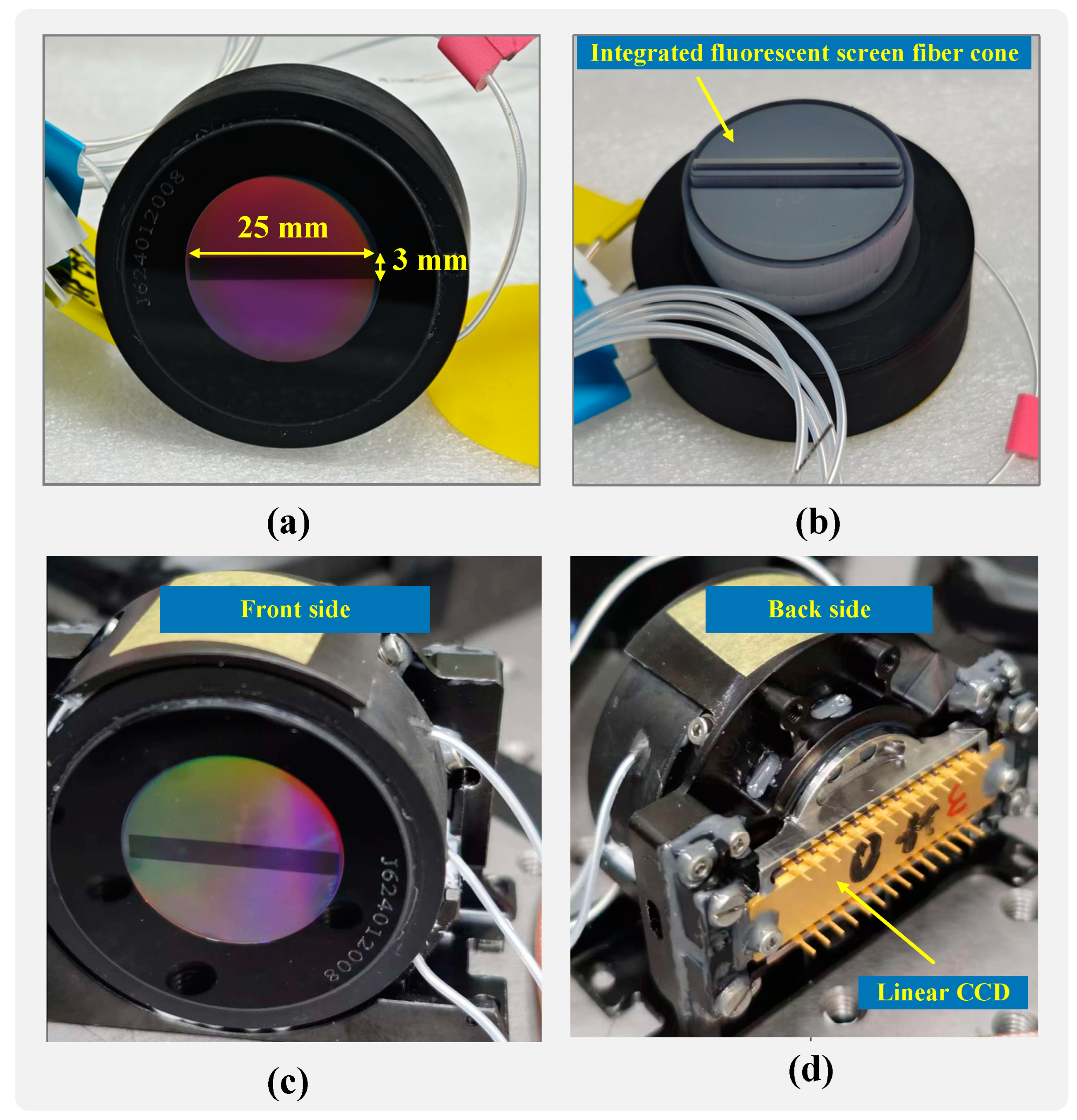
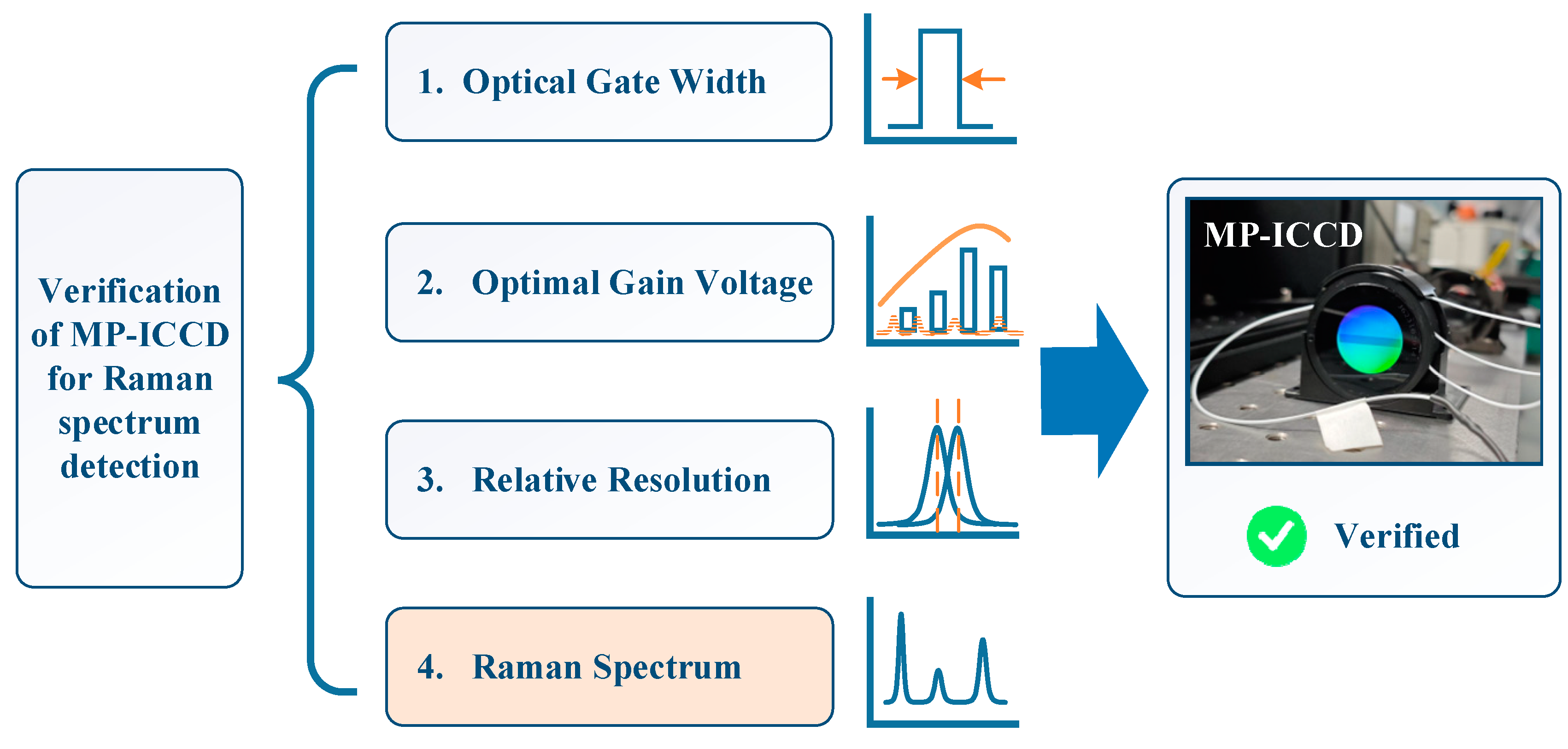
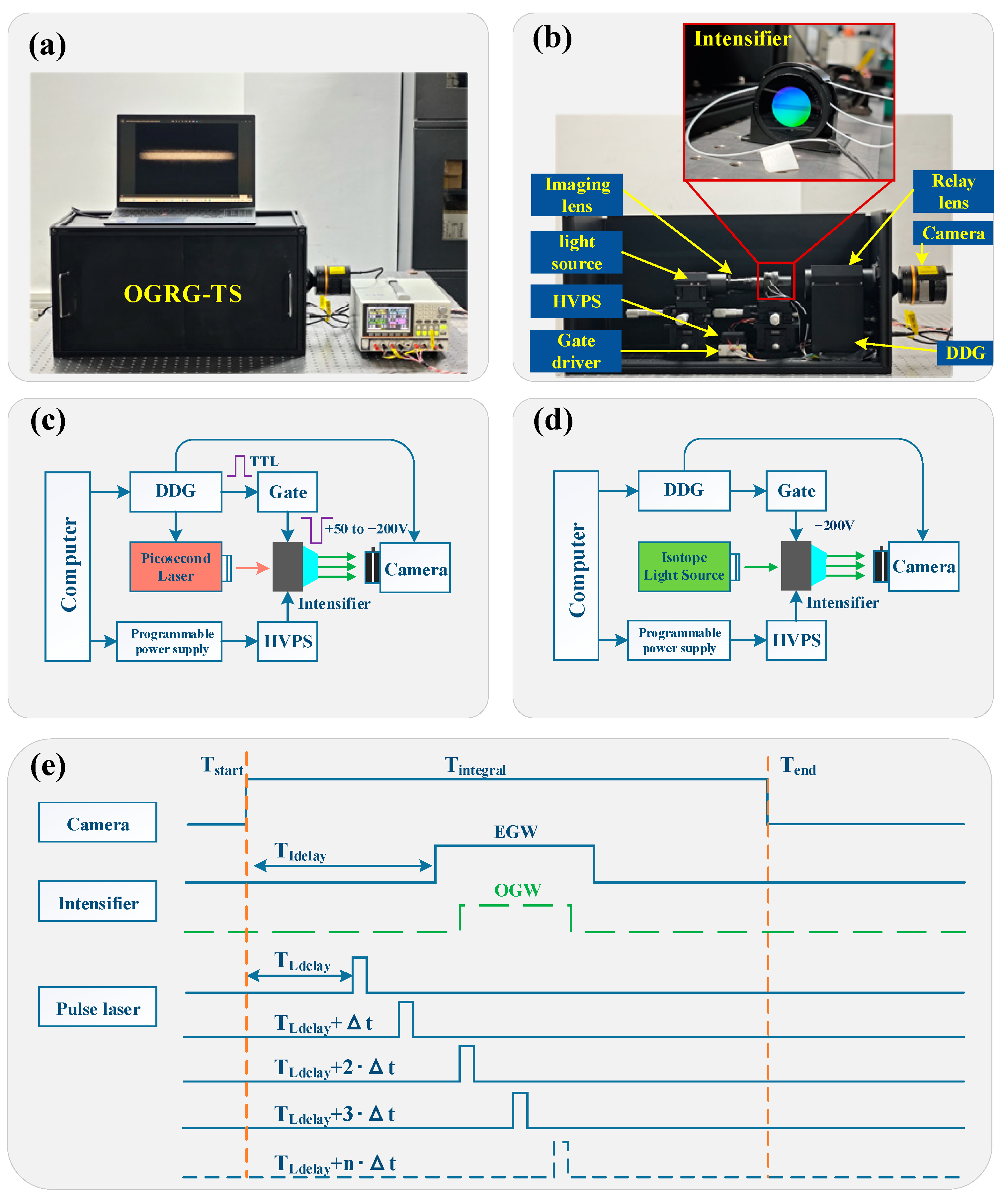

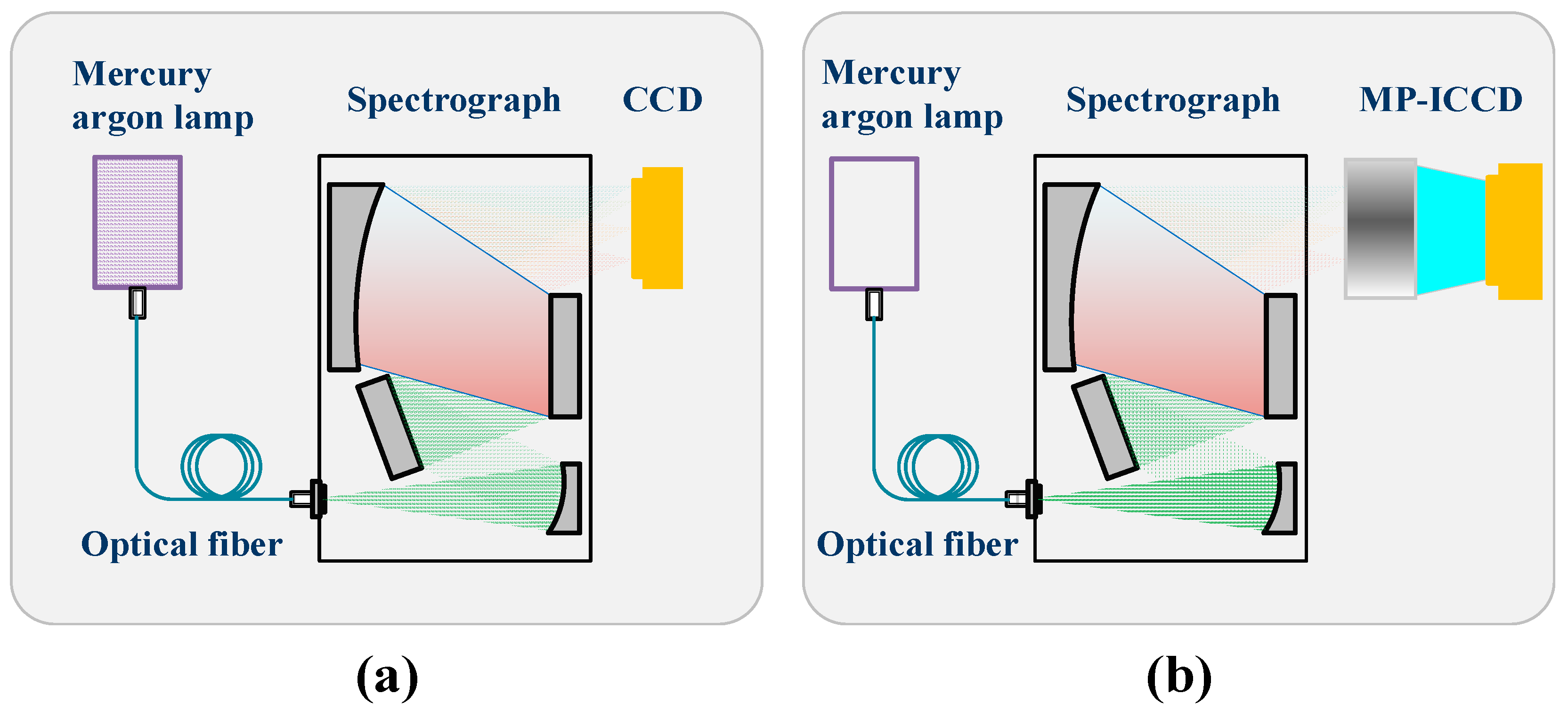
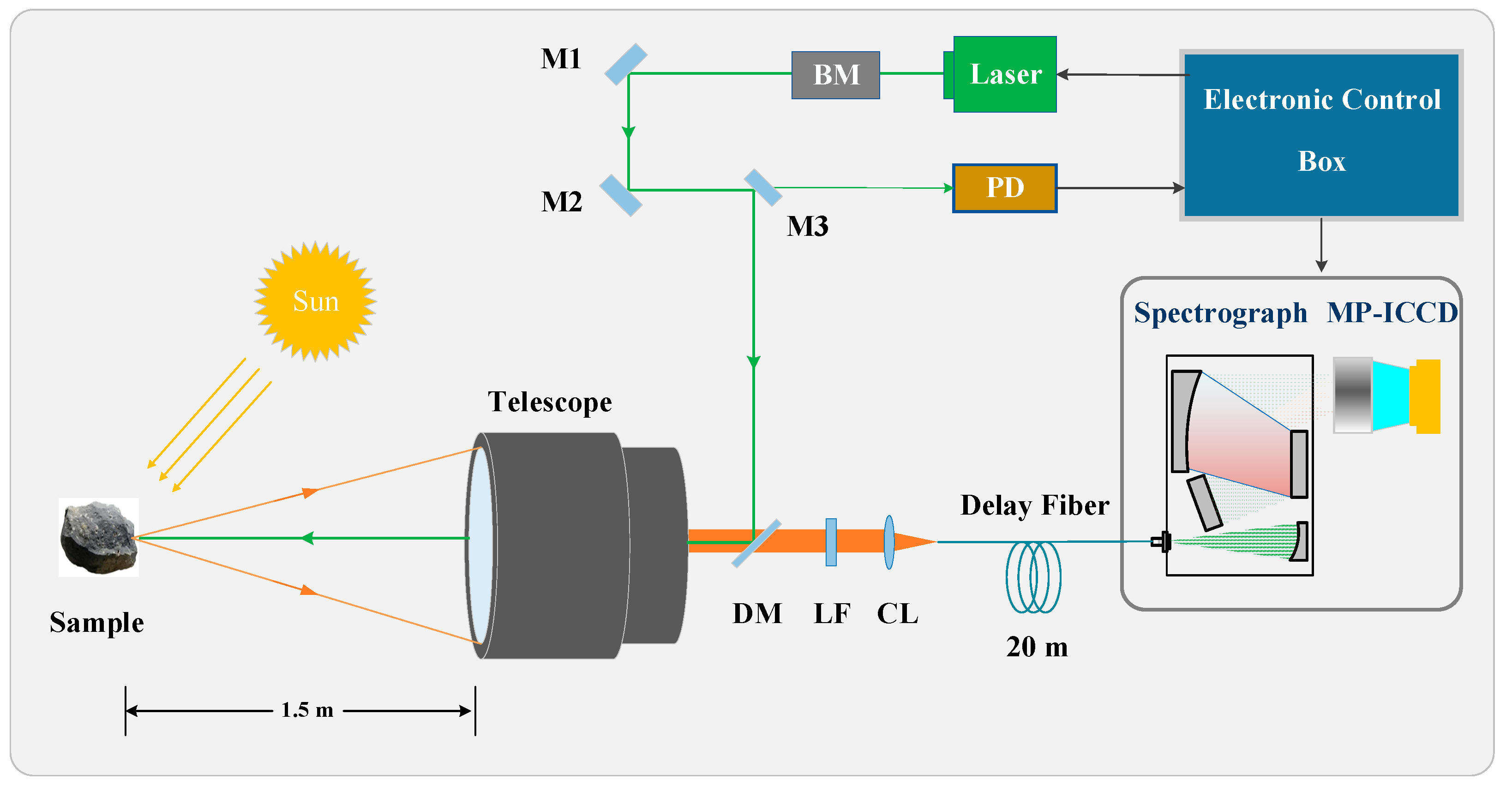

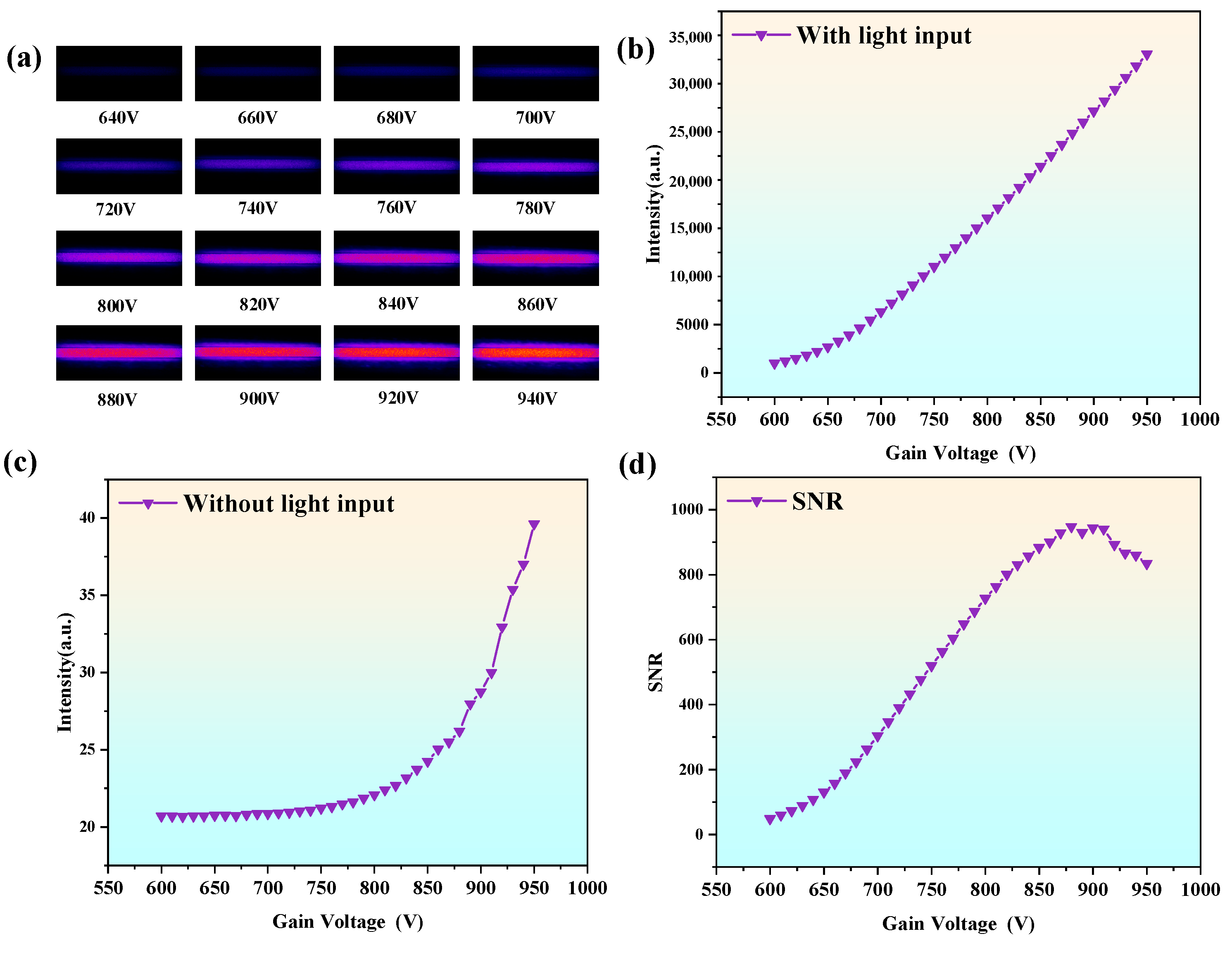
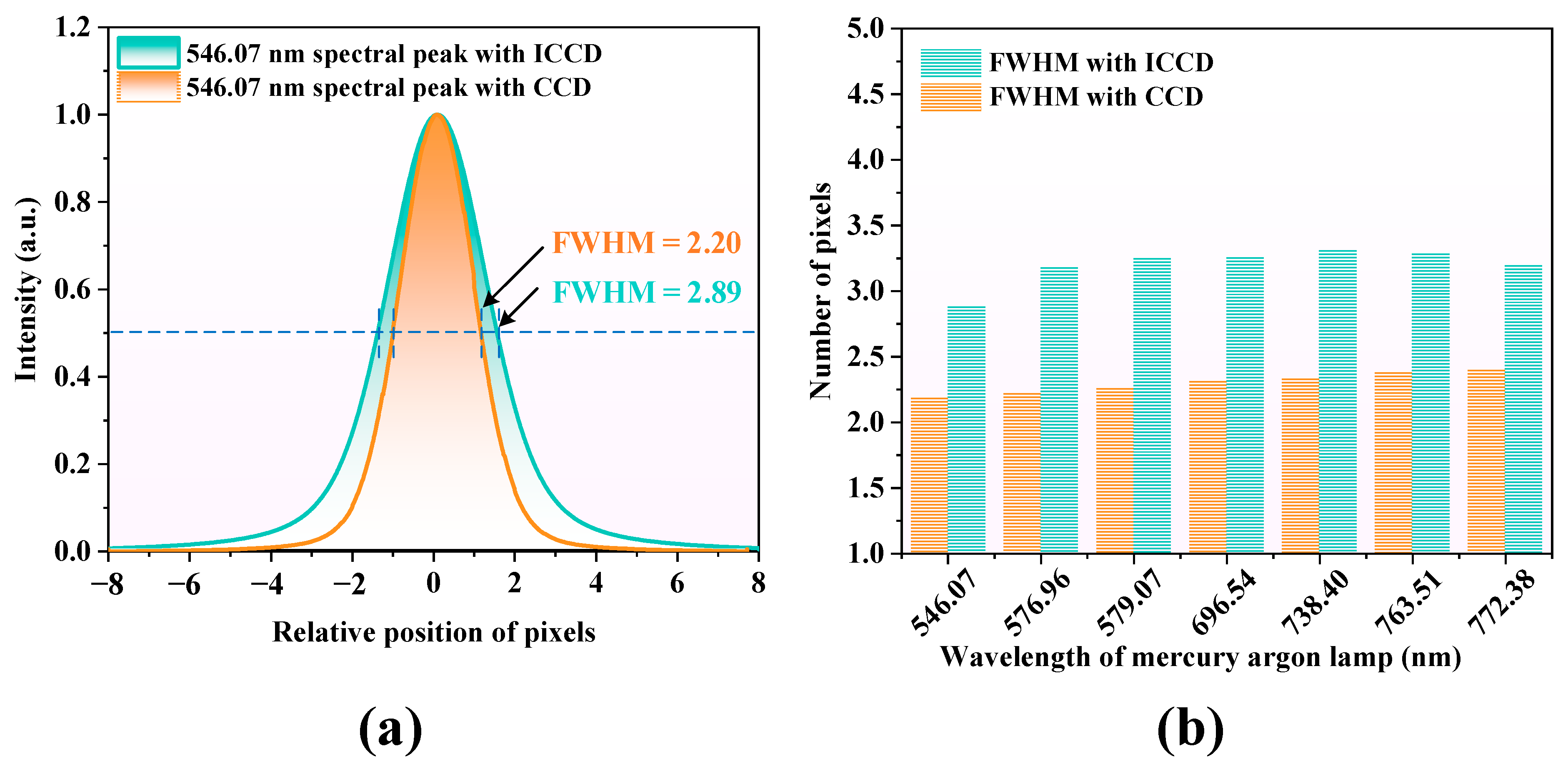

| No. | Mercury–Argon Lamp Spectral Lines (nm) | CCD Resolution (Pixel) | ICCD Resolution (Pixel) | Resolution Difference (Pixel) | Decay Rate |
|---|---|---|---|---|---|
| 1 | 546.07 | 2.20 | 2.89 | 0.69 | 31% |
| 2 | 576.96 | 2.23 | 3.19 | 0.96 | 43% |
| 3 | 579.07 | 2.27 | 3.26 | 0.99 | 44% |
| 4 | 696.54 | 2.32 | 3.27 | 0.95 | 41% |
| 5 | 738.40 | 2.34 | 3.32 | 0.98 | 42% |
| 6 | 763.51 | 2.39 | 3.30 | 0.90 | 38% |
| 7 | 772.38 | 2.41 | 3.21 | 0.80 | 33% |
Disclaimer/Publisher’s Note: The statements, opinions and data contained in all publications are solely those of the individual author(s) and contributor(s) and not of MDPI and/or the editor(s). MDPI and/or the editor(s) disclaim responsibility for any injury to people or property resulting from any ideas, methods, instructions or products referred to in the content. |
© 2025 by the authors. Licensee MDPI, Basel, Switzerland. This article is an open access article distributed under the terms and conditions of the Creative Commons Attribution (CC BY) license (https://creativecommons.org/licenses/by/4.0/).
Share and Cite
Zhao, H.; Liu, X.; Chen, C.; Xu, W.; Xie, J.; Zhang, Z.; Jiang, Z.; Xu, X.; He, Z.; Shu, R.; et al. Development and Testing of a Novel Microstrip Photocathode ICCD for Lunar Remote Raman Detection. Sensors 2025, 25, 1528. https://doi.org/10.3390/s25051528
Zhao H, Liu X, Chen C, Xu W, Xie J, Zhang Z, Jiang Z, Xu X, He Z, Shu R, et al. Development and Testing of a Novel Microstrip Photocathode ICCD for Lunar Remote Raman Detection. Sensors. 2025; 25(5):1528. https://doi.org/10.3390/s25051528
Chicago/Turabian StyleZhao, Haiting, Xiangfeng Liu, Chao Chen, Weiming Xu, Jianan Xie, Zhenqiang Zhang, Ziqing Jiang, Xuesen Xu, Zhiping He, Rong Shu, and et al. 2025. "Development and Testing of a Novel Microstrip Photocathode ICCD for Lunar Remote Raman Detection" Sensors 25, no. 5: 1528. https://doi.org/10.3390/s25051528
APA StyleZhao, H., Liu, X., Chen, C., Xu, W., Xie, J., Zhang, Z., Jiang, Z., Xu, X., He, Z., Shu, R., & Wang, J. (2025). Development and Testing of a Novel Microstrip Photocathode ICCD for Lunar Remote Raman Detection. Sensors, 25(5), 1528. https://doi.org/10.3390/s25051528






